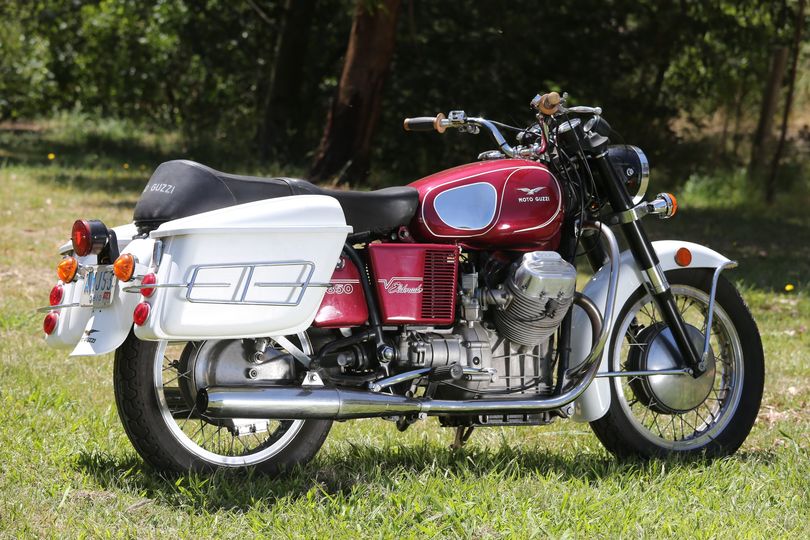Motorcycle Investor mag
Subscribe to our free email news
Moto Guzzi V7
(by Ian Falloon, May 2022)

Italy's
class-leading tourer
Although at one time
Moto Guzzi led the world on the racetracks, all that
ended in 1957. That year Australian
Keith Campbell gave Moto Guzzi its final World
Championship, the 350cc title,
but the next decade saw Moto Guzzi teeter on the brink
of disaster.
During the 1950s Moto
Guzzi prospered by producing large numbers of very
ordinary motorcycles and
Guzzi’s directors, wooed by complacency, completely
underestimated the significance
of the small car for mass transportation. Whereas during
the 1950s the Italians
were clambering for basic motorcycles, when prosperity
arrived in the mid-1960s
they deserted motorcycles for cars, mainly the Fiat 500.
Much of Guzzi’s plant
and machinery was out of date, and Moto Guzzi almost
followed dozens of other
Italian manufacturers into extinction. They were saved
by the V7, a transverse
90-degree V-twin with shaft drive.
Once upon a time Moto
Guzzi was known for horizontal singles, but since 1967,
the V7 layout has
become the Guzzi trademark, and it continues to form the
basis of all current
modern Moto Guzzis.
The V7 engine was
extremely advanced for its day and, apart from overhead
camshafts and
four-valves per cylinder, even the current 1400cc
variants are remarkably
similar. The all-alloy engine included pushrod-operated
overhead valves, with
the camshaft situated between the cylinders. Unlike most
motorcycle engines of
the time the one-piece steel crankshaft used plain
big-end and two plain main
bearings.
Ignition was by
battery and coil, with an automotive-type distributor
driven off the rear of
the camshaft.
The clutch and final
drive followed automotive rather than traditional
motorcycle practice. Bolted
to the rear of the crankshaft was a flywheel housing a
twin plate dry clutch,
and the final drive was by shaft inside the right side
of the swingarm. A
universal joint was connected to the gearbox layshaft
and the rear of the drive
shaft to a pair of bevel gears. It was rugged and
reliable.
With the United States
the largest market for the V7, there were calls for more
displacement, and for
1968 the engine grew to 757cc, for the 750 Ambassador.
The next evolution was
for 1972, Guzzi’s big tourer becoming 850cc. Known as
the 850 GT, or Eldorado,
in America, this lasted through until 1974. The power
was up to a respectable
65 horsepower at 6500 rpm, there was now a five-speed
gearbox, but some
anachronistic features, such as the belt-driven Marelli
dynamo, remained.
The chassis was
inherited from the V7, the large loop frame designed for
strength rather than
lightness, with 18-inch wheels front and rear. Some
examples retained the V7’s
double leading shoe front brake, while others included
the more effective four
leading shoe type of the contemporary V7 Sport.
One thing that didn’t
change was the size and weight. The 850 GT was built to
last and weighed a
considerable 235kg. Even so, it was capable of a
respectable 190km/h in the
right conditions, and was the mainstay of Guzzi’s
line-up during 1972 and 1973.
By 1974, a disc
replaced the front drum brake, but by now Alessandro De
Tomaso was in control
and a new era of production rationalisation had begun.
De Tomaso wanted to end
all twin cylinder production to concentrate on the
Honda-derived four and
six-cylinder models and the 850 GT was the last of the
traditional large
loop-frame Guzzis.
As tradition dies hard
at Maranello, this wasn’t the end of the twin. While the
multis withered away,
the big twin survived, but not the loop-frame 850 GT and
Eldorado.
Replaced by the 850 T,
the next generation of twins had the more sporting Tonti
frame and this would
see Guzzi through the next couple of decades.
While not particularly
rare, the Moto Guzzi loop-frame big-twins, like this
1972 850 Eldorado, still
offer exceptional cruising ability with long-term
reliability. They were
designed to run for long mileages, and with big seats
and high handlebars
provide exceptional touring comfort. Other Guzzis may be
more glamorous, but
the loop-frame twins are for the touring cognoscenti.
-------------------------------------------------
Produced by AllMoto abn 61 400 694 722
Privacy: we do not collect cookies or any other data.

Archives
Contact





